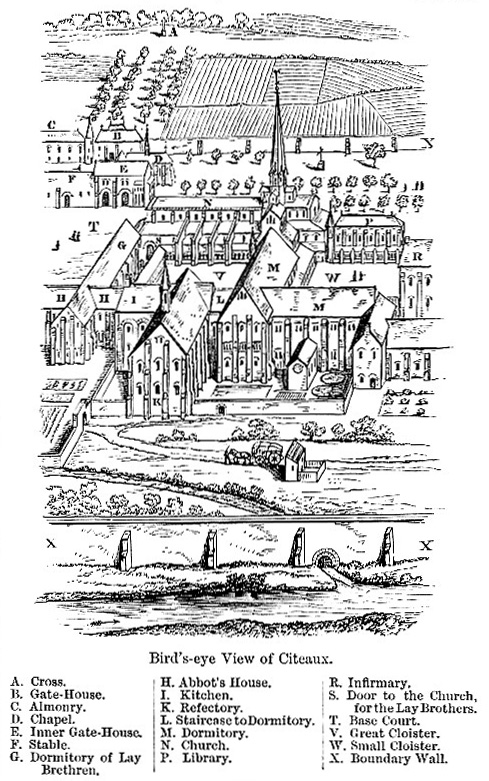A cross (A), planted on the high road directs travelers to the gate of the monastery, reached by an avenue of trees. On one side of the gate-house (B) is a long building (C), probably the almonry, with a dormitory above for the lower class of guests. On the other side is a chapel (D). As soon as the porter heard a stranger knock at the gate, he rose, saying, Deo gratias, the opportunity for the exercise of hospitality being regarded as a cause for thankfulness. On opening the door he welcomed the new arrival with a blessing -- Benedicite. He fell on his knees before him, and then went to infirm the abbot. However important the abbot's occupations might be, he at once hastened to receive him whom heaven had sent. He also threw himself at his guest's feet, and conducted him to the chapel (D) purposely built close to the gate. After a short prayer, the abbot committed the guest to the care of the brother hospitaller, whose duty it was to provide for his wants, and conduct the beast on which he might be riding to the stable (F), built adjacent to the inner gate-house (E). This inner gate conducted into the base court (T), round which were placed barns, stables, cow-sheds, &c. On the eastern side stood the dormitory of the lay brothers, fraters conversi (G), detached from the cloister, with cellars and storehouses below. At (H), also outside the monastic buildings proper, was the abbot's house, and annexed to it the guest-house. For these buildings there was a separate door of entrance into the church (S). The large cloister, with its surrounding arcades, is seen at V. On the south end projects the refectory (K), with its kitchen at (I), accessible from the base court. The long gabled building on the east side of the cloister contained on the ground floor the chapter-house and calefactory, with the monks' dormitory above (M), communicating with the south transept of the church. At (L) was the staircase to the dormitory. The small cloister is at (W), where were the carois or cells of the scribes, with the library (P) over, reached by a turret staircase. At (R) we see a portion of the infirmary. The whole precinct is surrounded by a strong buttressed wall (XXX), pierced with arches, through which streams of water are introduced. It will be noticed that the choir of the church is short, and has a square end instead of the usual apse. The tower, in accordance with the Cistercian rule, is very low. The windows throughout accord with the studied simplicity of the order.
Read the rest of this article:
Abbey - Table of Contents
